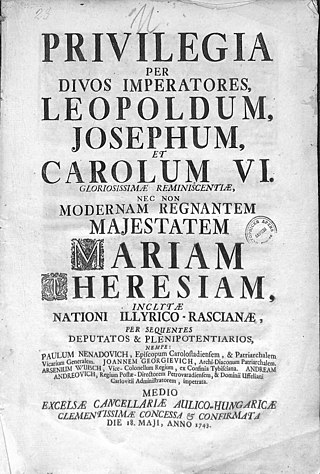The Eastern Orthodox Church, officially the Orthodox Catholic Church and commonly known simply as the Orthodox Church is a communion composed of up to seventeen separate autocephalous (self-governing) hierarchical churches that profess Eastern Orthodoxy and recognise each other as canonical (regular) Eastern Orthodox Christian churches.

The Ecumenical Patriarchate of Constantinople is one of the fifteen to seventeen autocephalous churches that together compose the Eastern Orthodox Church. It is headed by the Ecumenical Patriarch of Constantinople.

An exarch was the holder of any of various historical offices, some of them being political or military and others being ecclesiastical.
Eparchy is an ecclesiastical unit in Eastern Christianity that is equivalent to a diocese in Western Christianity. An eparchy is governed by an eparch, who is a bishop. Depending on the administrative structure of a specific Eastern Church, an eparchy can belong to an ecclesiastical province, but it can also be exempt. Each eparchy is divided into parishes, in the same manner as a diocese in Western Churches. Historical development of eparchies in various Eastern Churches was marked by local distinctions that can be observed in modern ecclesiastical practices of the Eastern Orthodox Church, Oriental Orthodox Churches and Eastern Catholic Churches.

The Serbian Orthodox Church is one of the autocephalous Eastern Orthodox Christian churches.
The Standing Conference of the Canonical Orthodox Bishops in the Americas (SCOBA) was an organization of bishops from Eastern Orthodox Christian jurisdictions in the Americas. It acted as a clearinghouse for educational, charitable, and missionary work in the Americas. In 2010, it was replaced by the Assembly of Canonical Orthodox Bishops of North and Central America.

The Bulgarian Orthodox Church, legally the Patriarchate of Bulgaria, is an autocephalous Eastern Orthodox jurisdiction based in Bulgaria. It is the first medieval recognised patriarchate outside the Pentarchy and the oldest Slavic Orthodox church, with some 6 million members in Bulgaria and between 1.5 and 2 million members in a number of other European countries, Asia, the Americas, Australia, and New Zealand. It was recognized as autocephalous in 1945 by the Ecumenical Patriarchate of Constantinople.

Eastern Orthodoxy in Italy refers to adherents, religious communities, institutions and organizations of Eastern Orthodox Christianity in Italy. In 2014, there were 14 distinctive Eastern Orthodox jurisdictions on the territory of Italy, some of them belonging to canonical Eastern Orthodox churches, while others are classified as independent (noncanonical). First session of the Council of Canonical Orthodox Bishops in Italy was held in 2009.
Eastern Orthodoxy in France is the totality of all Eastern Orthodox churches in France.
Eastern Orthodoxy in North America represents adherents, religious communities, institutions and organizations of Eastern Orthodox Christianity in North America, including the United States, Canada, Mexico, Central America, and the Caribbean. Estimates of the number of Eastern Orthodox adherents in North America vary considerably depending on methodology and generally fall in range from 3 million to 6 million.

Eastern Orthodoxy in Austria refers to communities, institutions and organizations of the Eastern Orthodox Christianity on the territory of modern Austria. There are several Eastern Orthodox jurisdictions in Austria. As of 2019, it is estimated that there are some 400,000 to 450,000 Eastern Orthodox believers in Austria. Most of them are ethnic Serbs and Romanians.
The Assembly of Canonical Orthodox Bishops of Latin America, formerly known as the Episcopal Assembly of South America, consists of all the active Orthodox bishops in Latin America, representing multiple jurisdictions. It is not, properly speaking, a synod. It is one of several such bodies around the world which operate in the so-called "diaspora."
The Assembly of Canonical Orthodox Bishops of Canada is an organization of church hierarchs of Eastern Orthodox Churches in Canada.
The Assembly of Canonical Orthodox Bishops of Australia, New Zealand, and Oceania consists of all the active Orthodox bishops in Oceanía representing multiple jurisdictions. It may be considered a successor to SCCOCA [Standing Conference of Canonical Orthodox Churches in Australia]. However, it is not, properly speaking, a synod. It is one of several such bodies around the world which operate in the so-called "diaspora."
The Assembly of Canonical Orthodox Bishops of Great Britain and Ireland consists of all the active Orthodox bishops of the British Isles, representing multiple jurisdictions. It is not, properly speaking, a synod. The Episcopal Assembly of the British Isles is one of several such bodies around the world which operate in the so-called "diaspora."
The Assembly of Canonical Orthodox Bishops of France consists of all the active Orthodox bishops serving France and Monaco, and representing multiple jurisdictions. It is not, properly speaking, a synod. It is one of several such bodies around the world which operate in the so-called "diaspora."
The Assembly of Canonical Orthodox Bishops of Belgium, Holland, and Luxembourg consists of all the active Eastern Orthodox bishops in Belgium, the Netherlands, and Luxembourg, and representing multiple jurisdictions. It is not, properly speaking, a synod.
The Assembly of Canonical Orthodox Bishops of Austria consists of all the active Eastern Orthodox bishops in Austria and Hungary, and representing multiple jurisdictions. It is not, properly speaking, a synod. The Episcopal Assembly of Austria is one of several such bodies around the world which operate in the so-called "diaspora."
The Assembly of Canonical Orthodox Bishops of Germany consists of all the active Eastern Orthodox bishops in Germany, and representing multiple jurisdictions. It is not, properly speaking, a synod. The Episcopal Assembly of Germany is one of several such bodies around the world which operate in the so-called "diaspora."
The Assembly of Canonical Orthodox Bishops of Switzerland and Lichtenstein consists of all the active Eastern Orthodox bishops in Switzerland and Liechtenstein, and representing multiple jurisdictions. It is not, properly speaking, a synod. The Episcopal Assembly of Switzerland and Lichtenstein is one of several such bodies around the world which operate in the so-called "diaspora."








